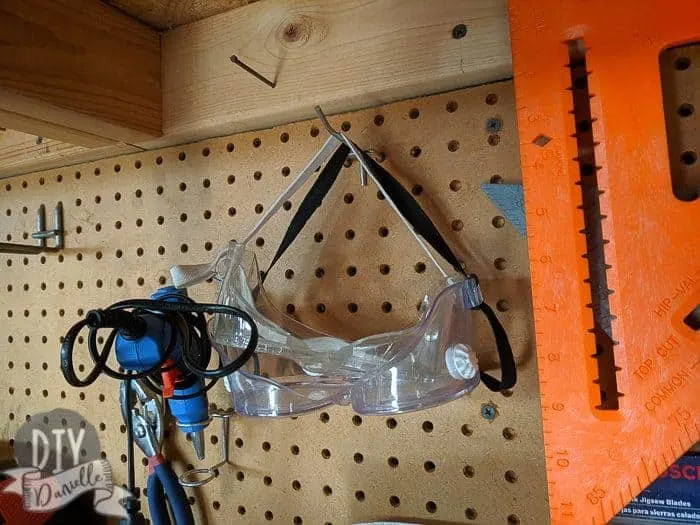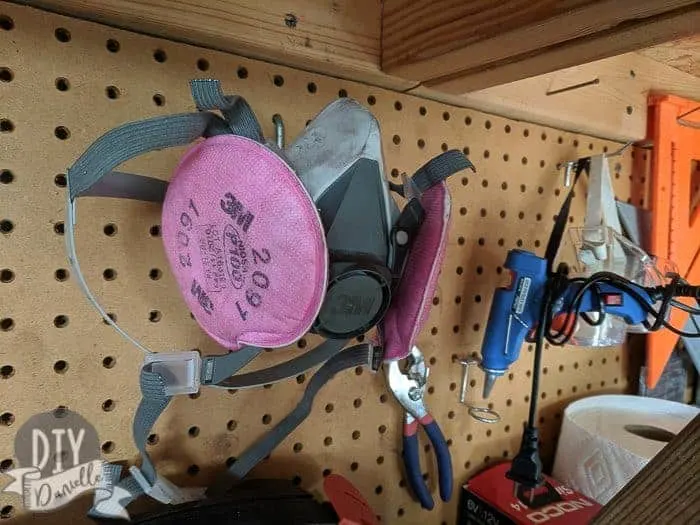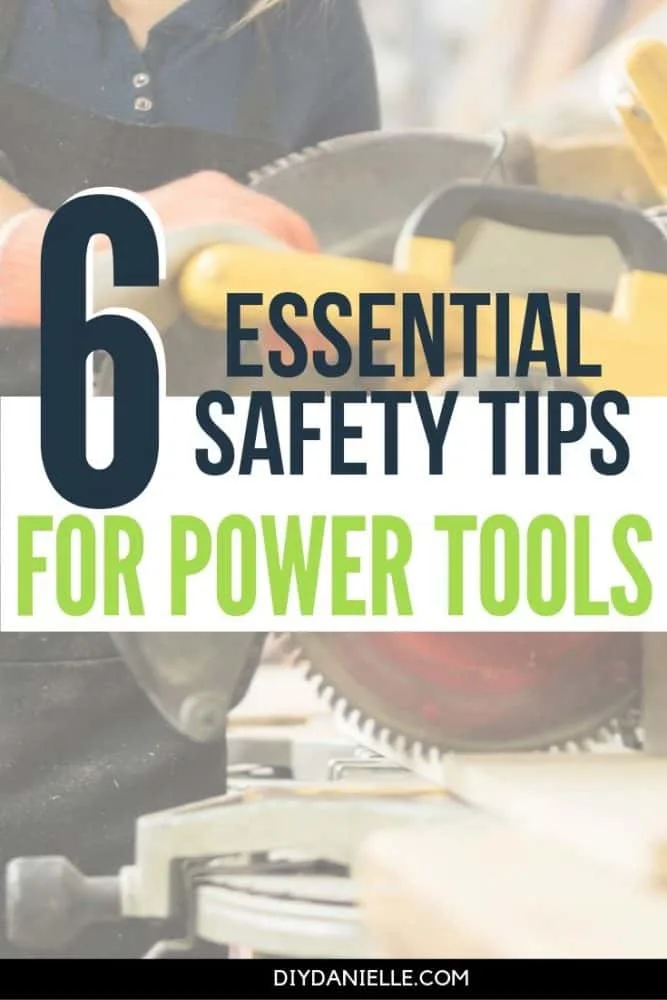
Essential safety tips for using power tools. Make sure you’re following these guidelines for safety when crafting or woodworking.
This post may contain affiliate links which may earn me commissions should you click through them and take certain actions. As an affiliate for Amazon, Cricut, xTool, Home Depot, and other sites, I earn from qualifying purchases. Please DIY carefully. View my full legal disclosures here.
Please read the whole post so you don’t miss any important information!
Welcome! Today’s guest post was written by Dylan Bartlett of Just a Regular Guide. Check out his other guest post on my blog, How to Upgrade Your Garage for the Higher ROI. -Danielle
For just about any DIY project, you’ll have to rely on at least a few power tools to get the job done. Whether you already know how to use them or you’re a first-timer, it doesn’t change the fact that a power tool is no joke. With one wrong move, you can seriously injure yourself or someone else working alongside you.
Safety Tips for Power Tools
That’s why you should learn — then regularly brush up on — safety tips for using any sort of power tool. To simplify that task, here’s the essential list of must-dos on your next power-tool-centric project.
1. Start With the Instruction Manual
It may seem as though most power tools are intuitive. You plug them in, turn them on and get to work. Still, you should read the user’s guide before you jump into a project with a specific tool.
As it turns out, just about every tool will come with a unique set of safety recommendations and limitations. Knowing these before you start will protect you throughout your job.
2. Wear the Proper Gear
Now that you know how to use your tool(s), protect yourself while doing so. Every DIYer should have a drawer full of safety gear containing at least five required pieces.
- OSHA-approved safety glasses: Popular Mechanic recommends that you have multiple pairs available if your DIY projects take place in a workroom. That way, you can reach for them as you need them, and protection will be at arm’s length.
- A pair of earmuffs: There’s no getting around the fact that power tools are noisy. Such high-pitched, high-volume tones can damage your hearing in the long term.
- A respirator: If you’re performing a task that would decrease the air quality or fill it with toxins, such as fiberglass, you won’t want to breathe in anything that could compromise your health.
- A pair of work gloves: Sturdy work gloves can protect your hands from calluses, cuts and other painful side effects.
- Steel-toed boots: Look for a quality pair of boots or other heavy-duty shoes made for construction or DIY work to keep you from slipping. They’ll protect your feet in case you drop something, too.
Donning the proper gear means ditching dangerous clothing items and accessories. Be sure to avoid loose-fitting clothing that could get caught up in your power tools. The same goes for jewelry and hair. Keep any loose strands back with a ponytail, headband or both.

3. Prepare the Work Area
Once you’ve dressed in the safest gear, make sure the work space won’t cause any hindrances or, worse yet, danger to you as you complete your project. Start by examining your work area.
Do you have enough room to maneuver around without bumping into anything? Are there any uneven spots in the floor that could trip you? Keep an eye out for obstacles that could pose a problem mid-job.
Next, make sure you have enough light. A dimly lit workspace could be problematic in many ways that you can probably imagine already. Even shadows can cause you to measure incorrectly and make a mistake, so be sure the bulbs are bright enough to illuminate every inch of your work area.
Finally, clear away any debris that could be an obstacle, as previously mentioned. Also, get rid of anything that could move around and get into your workspace. You should remove flammable debris, such as paper shreds, before you start working, too.
4. Practice Good Tool Technique
With your person and your space prepared for power tool work, be sure you’re using each piece of equipment as safely as possible. Start by checking their on-off switches. Each should be in the off position before you plug it in.
Once you turn on the chosen tool, keep a close eye on how it’s functioning. If something seems off, cease using the equipment and pause your project.
Even with a tool that’s working correctly, you might need to make some changes. For instance, you might need to swap out the bit on an electric drill. You should not only turn off the device before you do so, but allow it to cool down, too. Otherwise, you could burn your hand on a recently used tool.
To that end, every tool manufacturer will create and sell accessories that go with their tool model. Make sure to only purchase authorized parts built specifically to fit your power tool.
Hold onto the tool with both hands as you use it. Be sure to keep both feet firmly planted, too — over-reaching to complete a task could cause an injury, too.
5. Power up Properly
These tools require a power source to run. You can purchase some cordless varieties of smaller handheld tools, such as drills. In doing so, make sure you buy one that’s up to snuff safety-wise. Also, prepare yourself that the tool you’ll be holding will have a much larger handle than other models that lack a built-in battery. These power sources require lots of space within the tool itself.
Not every tool comes with a cordless option, though, nor should they. Larger pieces of equipment need stronger, more steady sources of electricity, so you’ll have to plug them in. You run the risk of tripping over cords, so remain aware of where you’ve plugged in your equipment.
Invest in high-quality extension cords to make jobs easier and safer. And make sure your chosen cord has a socket to match your power tool of the day. You should never put a three-pronged plug into a two-pronged extension socket.
6. Finish Strong
Now that you know how to prepare and operate your tools, it’s time to finish the job strongly and safely. If you feel your focus waning, call it a day. You should never operate such machinery while you feel unfocused or drowsy. And never sub a similar tool for the one you need. Either do the job right or wait until you can. Your safety isn’t worth the shortcut.
Once you finish, the job doesn’t end with the last stroke of the power tool. Instead, you should wipe down, dismantle and safely store each item you’ve used. A dry, clean spot will preserve your power tools and prevent environmental damage that could lead to malfunctions down the line. And, as we mentioned already, such malfunctioning could pose a safety hazard to you while you work.
Tip from Danielle: If you have kids visiting your workshop, store your tools separate from their batteries. We have a charging station setup high along the wall where we store our batteries. It's out of reach from young children so they can't accidentally turn on any of our power tools. You should also make sure any sharp items, glues, or toxic chemicals are out of reach and secure on their shelves.
Moving Forward
You’re probably thinking that much of this list is common sense, and that’s because most safety tips are. However, each one bears mentioning and repeating because of the strength that comes with the power tool in your hand.
So educate yourself, dress well and use each tool properly. Then you can finish your DIY project well and without incident, paving the way for your next project — which will also go off without a hitch because of just how prepared you are.
Author Bio

Dylan Bartlett writes about home improvement and DIY projects on his site, Just a Regular Guide. Follow him on Twitter @theregularguide to get frequent updates on his work.
This is not intended to be a complete list- there are always additional safety consideration when you’re building. What would YOU add to this list? What’s your worst woodworking injury?
LOVE woodworking and looking for fun build ideas? Check out these projects: Living Room Bookshelves | DIY Recessed Shelves | Easy to Build 2x4 Projects | Custom Wood Screen Door | Wood Toilet Paper Holder
Please share and pin this post! If you make this project, share it in our Stuff Mama Makes Facebook Group. We have regular giveaways for gift cards to craft stores. You can also tag me on Instagram @doityourselfdanielle; I love seeing everything you make!


Cali Pierce
Sunday 7th of August 2022
This was beautiful Admin. Thank you for your reflections.